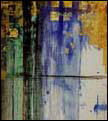 Arts & Literature
Arts & Literature
 Arts & Literature
Arts & Literature
Where do the fine arts and religion meet? Has the Church awakened to its part in the dialogue? From the increasingly popular Image Journal to poets such as Luci Shaw and artists such as Makoto Fujimura, evangelicals seem to finally be taking fine arts as a calling seriously. Legendary author C.S. Lewis once remarked that we do not need more books about Christianity, but rather more Christians writing good books.
How should Christian literature and other art forms help shape public discourse? Public policy? Private and family lives? Conversely, how should Christians allow art to shape their own lives? These are all questions that require deeper reflection than is often given them. We offer you a place to begin reflecting in our classic articles below.
(Image at top right is a portion of Grace Foretold, a painting by Makoto Fujimura, 1997).
Christianity And The Arts: Imagination Redeemed to Impact the World
A Dialogue with Luci Shaw, Interviewed by Stephanie Kirtland
In a candid and insightful dialogue, Luci Shaw, one of our foremost poets, discusses everything from the role of the arts to the transcendent, poetic power of asparagus.
Martha Nussbaum, Poet's Defender
Review by Alan Jacobs
"Poetic Justice: The Literary Imagination and Public Life" by Martha Nussbaum is the subject of this review. Good introduction to a writer on a years-long mission to demonstrate the radical concept of compatibility between literature and certain branches of philosophy. The reviewer finds the observations of her latest work to be both fascinating and flawed, which he skillfully extrapolates to her larger goal of bringing poetry/literature together with the economic/political realm.
The Light of the World: Poetic Imagery and the Gospel
Charles Colson, Breakpoint Commentary
Noting the affect of the popular Bill Moyers book, The Language of Life, culture-watcher and author Chuck Colson urges readers to communicate the message of hope found in the Scripture to people through the emotional gateway of poetry.
Criteria for Christian Appreciation of the Arts
Lance Box
A teacher at a Christian school gives six criteria for appreciating the arts from a Christian perspective. A brief but thought-provoking essay.
Faithful Companions And Guides: Art and Nature as God's Chosen Vocabulary
Ken Gire
Ken Gire writes that Michelangelo's painting on the ceiling of the Sistine Chapel-the one in which God is reaching his hand to Adam's, their fingers not quite touching-perfectly symbolizes God's relationship to humanity throughout history: whenever he succeeds in reaching us, a window opens between heaven and earth in a moment of revelation. Yet, how do such revelations come to us? The author's interaction with the work of Vincent van Gogh taught him what is required to hear God's voice through his creation and creatures: looking, listening, receiving.
The Scandal of Pleasure
Review by Hilton Kramer
Is art only what a particular critic thinks it is? Is there a criteria for beauty that transends opinion? These and other issues are discussed in this essay as Hilton Kramer reviews "The Scandal of Pleasure: Art in an Age of Fundamentalism" by Wendy Steiner.
Come, Bring Your Story
Don Hudson
A pastor's confession to losing interest in the Bible and his discovery: what he needed was not more discipline, but a renewed understanding of the intent and presentation of the Bible--as a grand storytelling. Hudson recounts two stories, one from within the Bible, one from without and compares them to show us the life-changing power of a story (as opposed to mechanical analysis), especially those stories that claim to be of God.
A Conversation with Madeleine L'Engle
Heather Webb
Not many people were listening when Madeleine L'Engle was convinced she was onto something with her children's story. Her manuscript, considered too strange and difficult for kids, was turned down by every major publisher. A Wrinkle in Time eventually won the prestigious Newbery Medal and has indelibly touched the imaginations of three generations of children and adults. The unabashed author holds forth here on unicorns, unity, and the end of physics.
Giving Shape To Turmoil: A Conversation with Chaim Potok
Michael J. Cusick
The notion of violent culture clashes-"confrontations of core elements," he calls them-has dominated the work of best-selling novelist, ordained rabbi, and world-class painter Chaim Potok. And not surprisingly: From his first eye-opening encounter with literature as a teenager, to his influential military experience in Asia, to his wrestling with the scriptures, the forces of life in twentieth-century America have shaped Potok's faith, perspective, and art.
Makoto Fujimura Special Section
Makoto Fujimura, a world-class painter who uniquely uses ancient Japanese techniques, boldly integrates his deep faith in Christ with his art. In this special section, you will find examples of his work as well as essays on what motivates and inspires him--in art and in faith.
The Character of God: Recovering the Lost Literary Power of American Protestantism
Review by Gregory Wolfe
The reviewer states that, "While there is much to admire in the historical sweep and literary intelligence of [the book]--and ample reason to support [its] dark story of a mighty tradition reduced to politicized theology--it is marred by questionable judgments."
George Rochberg's Revolution
Michael Linton
A renewed appreciation of artistic integrity and the prophetic role of the artist is very much the legacy of composer George Rochberg's musical revolt, and one for which we owe him our thanks.
Music Theory: A Liberal Art in Chains
Ken Stephenson
After centuries at the core of all higher education in Christian Europe, music theory now receives no visible distinctively Christian input to the detriment of both Christian culture and music theory. The author calls for a return of Christian music theory through examination of Christian pieces, consideration of composers as human creations, application of theory to ethics, contemplation of acoustics, and reconnection of music to the rest of God's world.